Episodes
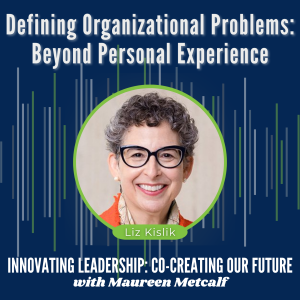
Friday Mar 03, 2023
Friday Mar 03, 2023
Guest: Liz Kislik
The way leaders define a problem comes from their experience of the problem and may not account for everything that’s going on. At the same time, there is almost always something they can do to improve their situation. Liz Kislik joins Maureen to discuss why it’s crucial for leaders to look deeply at what’s going on and the problem’s causes and sources to be able to work on the problem in the most effective ways.
How to Help Midlevel Leaders Grow and Develop
The following blog is provided by Liz Kislik. It is a companion to her interview on Innovating Leadership, Co-Creating Our Future titled Defining Organizational Problems: Beyond Personal Experience that aired on May 26th, 2020.
Midlevel leaders are absolutely crucial to managing the guts of an organization and accomplishing its business. Unfortunately, even competent, up-and-coming leaders can languish if they don’t get appropriate developmental attention from their senior leaders, but those senior leaders sometimes expect junior leaders to develop on their own.
In an interview I did with Amir Ghannad for The Transformative Leader podcast, we talked about how senior leaders can provide the right input to middle managers to ensure they’re achieving their own successes and supporting the organization’s continued growth.
Be Intentionally, Persistently Curious
Leaders often think of middle managers in terms of their roles and responsibilities and form monolithic assumptions about how middle managers are expected to think and what their considerations are. But every individual takes action based on what seems best to them at the time. If their choices seem wrong, probe to find out their reasons.
When leaders think, “Oh, that’s trivial. That’s dumb. I’ll just tell them to knock it off,” they’re actually undercutting their subordinates’ autonomy and ability to adjust and perform better. If you ask what prompted middle managers’ actions or comments instead of making assumptions, you can approach them in a more open, less judgmental way and you’ll seem less like a know-it-all. You’re also more likely to take their opinions and concerns more seriously.
During our conversation, Amir told me about two skillful, productive people who had been in conflict for 12 years based on a single mistaken impression. Once the mistake came to light, the relationship improved dramatically, but it took months of probing to uncover the original misapprehension. Amir’s story demonstrates that no directive to behave differently can effectively cut through someone’s deeply held pain (even if that pain is unnecessary) — and how finally getting to the bottom of a long-held conflict is a true relief.
Partner on Problems and Perspectives
Say you do figure out where your midlevel leader is coming from. You can’t do an improvement to them. You may be able to see what needs to change, but that doesn’t mean they’re ready to hear it. So, after finding out what they’re thinking, go to wherever the other person is mentally, and take their perspective rather than dictating to them from on high.
Unless it’s a true emergency, try to ignore your own reaction and the intensity of your beliefs about what would work better. Suppress your impulse to impose solutions, because when you slice through difficulties like the proverbial hot knife through butter, subordinates may not feel ownership for the situation. They may follow your directions but neglect to think broadly about costs and benefits, sequencing, or other operational details — even if they know more about operations than you do — and mistakes are more likely to be made.
Don’t Give Leaders Solutions; Teach Them How to Develop Solutions
The old saw, “Don’t bring me problems, bring me solutions!” is a common complaint among leaders who believe that their people don’t think and want to be spoon fed. Risk-averse middle managers may be comfortable having you act decisively and save them time and effort by telling them what to do. But in the long run, you build better solutions when more people contribute to them. And why create unnecessary dependency that slows down implementation and turns you into a bottleneck?
You may need to teach the people involved new ways of thinking and interacting if they’ve developed the habit of expecting you to call the shots. This kind of development requires coaching rather than directing. So, ask middle managers what factors lie under the scenarios they present, and to be explicit about pros and cons — not just as a general list, but as detailed, second-order potential consequences. Encourage them to hypothesize about why negative patterns recur and speculate about multiple potential alternatives.
As midlevel leaders begin to see you being consistently curious, open to their views, willing to partner, and supportive of their decision-making, not only will they be better partners for you but they also may start exhibiting those behaviors with their subordinates as well. That’ll help develop your next cadre of up-and-coming managers, and strengthen your organization from the bottom up.
Onward and upward —
About the Author
Liz Kislik is a management consultant and executive coach, and a frequent contributor to Harvard Business Review and Forbes. Her specialty is developing high performing leaders and workforces, and she helps family-run businesses, national nonprofits, and Fortune 500 companies like American Express, Girl Scouts, Staples, Janssen Pharmaceuticals and Highlights for Children solve their thorniest problems. Her TEDx talk, “Why There’s So Much Conflict at Work and What You Can Do to Fix It,” has been viewed over 160,000 times. Liz received her BA from Yale University and earned an MBA in Management from NYU.
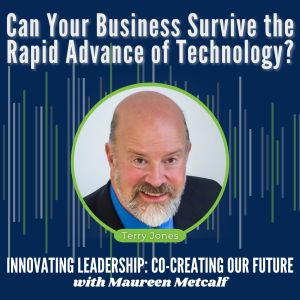
Friday Mar 03, 2023
Friday Mar 03, 2023
Guest: Terry Jones
The burning question many businesses should be asking is “Can our business survive and thrive the rapid advance of technology?” Today Terry Jones, the founder of Travelocity.com and founding chairman of Kayak.com, joins the show to discuss with Maureen how existing corporations can change and adapt to new products, as sometimes it's forgotten how to discover new things. His advice: “You better take a risk, if you don’t, you’ll be gone.”
Will Technology’s Next Big Innovation Be Your Company’s Downfall?
This blog is provided by Terry Jones, founder of Travelocity.com and founding chairman of Kayak.com. It is a companion to his podcast Can Your Business Survive the Rapid Advance of Technology?
It’s a scenario that gets played repeatedly in the corporate world.
One moment a company is riding high, the next it’s struggling to exist, its business model disrupted by new technology and a failure to keep up with an ever-changing competitive landscape.
Take as just one example Nokia, which at one time ruled the roost in the mobile-phone market, able to boast in the late 1990s that it was the world’s largest cellphone maker.
But when Apple introduced its iPhone in 2007, Nokia proved too slow to adapt as the market, the technology and the competition began to evolve all around it. Over the next several years, Nokia became an also-ran in an industry it previously dominated.
History is replete with similar stories, and you can expect more in the future as technology continues to advance at a head-spinning rate, says Terry Jones, founder of Travelocity.com, co-founder of Kayak.com, and author of the new book Disruption OFF: The Technological Disruption Coming for Your Company and What to Do About It (www.tbjones.com).
“Our constantly changing world is disrupting what many businesses do, whether it’s photography, the book industry, the music industry or many others,” Jones says. “In the business world, change is inevitable, but success is optional."
“Technological change can come quickly. For example, 90% of hearing aids are now produced by 3D printing and that change happened in just four years. Companies that didn’t make the change are no longer with us.”
That doesn’t mean any particular company is necessarily doomed, though.
“There are a surprising number of 100-year-old companies out there,” he says. “Most of the ones I’ve talked to have mastered the ability to shed their old skin and renew themselves when required.”
Jones says a few ways businesses can avoid becoming a disruption casualty include:
Be willing to take risks. “Your company was probably founded on risk, but you don’t take risks anymore,” Jones says. “But you have to take risks to move forward.” He says he speaks with many corporations that are envious of the speed with which Silicon Valley startups make decisions. “These nimble companies are constantly trying, failing, changing and moving on,” Jones says. “Disruption is in their DNA. Most larger corporations are not like that. They generally are deliberative, risk averse and ponderously slow. They focus on delivery more than discovery. That approach might have worked in a time of limited disruption, but not today.”
Create a culture open to new ideas. “Many businesses are stuck in corporate pinball,” Jones says. By that he means this: Each time someone dreams up a new idea, that idea gets bounced from department to department, as if its hitting the bumpers of a giant pinball machine. Each department finds a reason to say “no” to the idea, which eventually ends up in the gutter. “You have to stop closing the door and saying, ‘No,’ ” Jones says. “Your job is to get the idea to the finish line. To get it over, to say, ‘Yes.’ ”
Become a disrupter yourself. In this world of disruption, it’s unlikely your largest competitor will be your undoing, Jones says. The problem is those 5,000 to 6,000 new startups per year that are attacking the traditional world. “You need to put their ideas to work and become a disruptor yourself,” he says. “Disruption and innovation really are two sides of the same coin. You just call it a disruption because you didn’t do it.”
“A company may currently be strong and it may be run by intelligent executives, but the question is whether it’s adaptable enough to change,” Jones says. “Even more important, is the company proactively preparing for change? If so, it’s more likely to survive and maybe even thrive.”
About the Author
Terry Jones (www.tbjones.com), founder of Travelocity.com and founding chairman of Kayak.com, is author of the new book Disruption OFF: The Technological Disruption Coming for Your Company and What to Do About It. For the last 15 years he’s been speaking and consulting with companies on innovation and disruption. Jones began his career as a travel agent, jumped to two startups and then spent 20 years at American Airlines, serving in a variety of management positions including Chief Information Officer. While at American he led the team that created Travelocity.com, served as CEO for six years, and took the company public. After Travelocity he served as Chairman of Kayak for seven years until it was sold to Priceline for $1.8 billion.
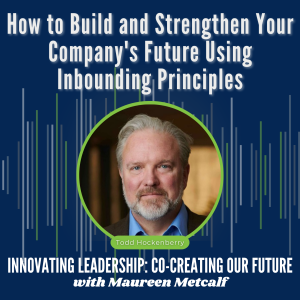
Friday Mar 03, 2023
Friday Mar 03, 2023
Guest: Todd Hockenberry
We are in a major shift in a fundamental aspect of how businesses grow, how buyers purchase, and how businesses build meaningful conversations and customer relationships. Companies who align their mission, strategies, action plans, and tools with the way buyers think, learn, discover, and purchase will have a huge competitive advantage. Organizations need to adjust their mindset and build a strategic foundation to deal with these facts and not just update a business plan. Todd joins Maureen to discuss his book, "Inbound Organization: How to Build and Strengthen Your Company’s Future Using Inbound Principles" and how leaders can focus their business on the customer and succeed at attracting and keeping the ideal customers.
Inbound Organization: How to Build and Strengthen Your Company's Future Using Inbound Principles
Todd Hockenberry provides this blog as a companion to his podcast Inbound Organization: How to Build and Strengthen Your Company's Future Using Inbound Principles.
To drive revenue growth in an uncertain environment, leaders need to change their thinking about how they view buyers.
The old formula of more: more marketing campaigns, more sales resources, more budget no longer assures leaders of a direct return.
Buyers, and the way they find information, evaluate options, consider vendor choices, and make decisions have changed. Yes, you say, of course the buyer has changed, and we have a better website, more content, and a social media presence.
But systemic shocks are accelerators of trends that were already underway. The rate of buyer behavior changes and buying process change is accelerating.
Has your thinking about buyers changed accordingly? What you knew about buyer behavior two years ago is probably obsolete at this point.
The companies that survive and thrive with predictable revenue engines in the new, new age of buyer control will be the ones that become inbound organizations – ones that are built for and solve for the customer, where everyone is aligned around the goals of the customer, and fully invested in the success of the customer.
“Many companies recognize the need to change marketing tactics, to use content, develop a digital marketing presence, and adapt to the ability of buyers to control the process. Few see it as fundamental to the operation, structure, and strategy of the entire organization.” *
People demand more from the companies they buy from. Companies, even those B2B companies in traditional industries, must realize that they are not just selling a product but delivering an entire customer experience from the first touch until the buyer no longer uses the product. Each step and each touch with the buyer either add to or detracts from the experience.
The goal is not the customer experience. The goal is to enable your customers to share their great experience and become your best advocates.
Customers that love the experience of working with your company will be your best marketers and best salespeople.
"The first and most important step is to shift the organization’s mindset to focus on solving for the customer. Make decisions based on what’s in their interest—because what is in the customer’s interest is in the organization’s interest too." Dharmesh Shah, HubSpot.
But wait you say, we put the customer first. Maybe your sales team does, maybe your product team does. But does your back office? Does your accounting team? Does your service team, or do they just react when the phone rings? Do you ensure your customers are successful with your product or do you set it up, get them going, and then forget about them until they have a problem?
Look at your marketing. Is the content of your campaigns, the text on your website, or the content of your presentations about your products (features, specifications, technical info) or is it about your customers? Does your sales team act as change agents and business peers or are they product-focused order takers?
Do you really know why and how your customers buy, or do you just hope the order shows up?
How do you make your entire business attractive, not just your inbound marketing?
Building an inbound organization starts with a mission and culture that places the goals of the target customer as the top priority. Solving for the customer means that everyone in the organization is aligned around the mission of the company. Your mission is the agreement and expression in a brief statement of how your company’s people, resources, time, products, and services help your target customer solve their problems, do the jobs they need to be done, and achieve their goals.
Very few companies we work with have a mission framed in these terms. If they have one at all it is usually full of buzzwords like best in class, high quality, and outstanding service, none of which mean anything to your customers or to your employees.
Can you state your company’s mission statement as you read this article?
The mission is important because it serves as a guide to all employees as they make decisions every day about how to use their resources to solve for the customer.
A vision is where your company wants to go, the mission is how it is going to get there. And both involve putting the customer’s goals and outcomes at the core.
Creating a clear mission also serves to tell your customers why you exist and becomes an attractive signal that your business is focused on them and their needs. Buyers have abundant options, even for most complex purchases, and they will increasingly choose to work with businesses that state and share their values.
The same idea holds for employees – if you want the best people you need to attract them with a compelling mission that aligns with their personal goals and beliefs.
Building a mission and culture of helping customers first
If your business develops a clear mission, then your culture is the environment that either drives everyone towards the mission or stands in the way. Culture is the sum of the values, attitudes, beliefs, and behaviors of leadership applied through the entire company.
Your culture drives alignment to the mission. A customer-focused culture aligns everyone with the goals of the customer.
“An inbound organization is guided by a philosophy, a set of core beliefs, and best practices that impact every person in every department to provide value and build trust with customers, partners, and anyone they touch.” *
Why does a customer-focused mission and culture drive revenue?
As Peter Drucker once said, “Culture eats strategy for breakfast.” A culture of customer focus, solving for the customer, with everyone aligned around the needs of the customer, and making sure customers are successful is the way to grow your business in this age of buyer control.
When leaders understand that their organizations are not as customer-focused as they think they are, they can explore how to align their mission, strategies, action plans, and tools with the way their buyers think, learn, discover, and purchase. These inbound organization ideas will help leaders focus their business on customers and succeed at attracting and keeping them at a rate that outpaces the competition.
* Inbound Organization: How to Build and Strengthen Your Company's Future Using Inbound Principles, Wiley (2018)
About the Author
Todd Hockenberry and Top Line Results specialize in leading top line revenue growth at small and medium-sized companies with a focus on Business-to-Business, manufacturing, technology, and capital equipment.
For over 11 years Top Line Results is a leader in educating and helping Business-to-Business companies adapt to the new realities of Internet-driven changes in buying behavior and to successfully grow their businesses.
Todd is the co-author of the book Inbound Organization: How to Build and Strengthen Your Company's Future Using Inbound Principles.
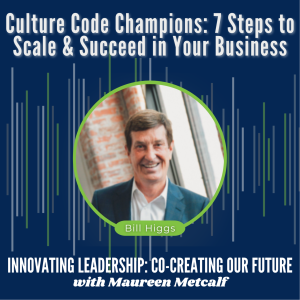
Friday Mar 03, 2023
Friday Mar 03, 2023
Guest: Bill Higgs
People are the crux of any organization’s success, but many businesses don’t take any intentional steps to create an energetic, positive work environment that spirals people’s attitudes upward. Yet, the right culture can help you create a ‘cycle-proof’ business that can grow even during your industry’s bust cycles that inflict economic pain on competitors. Bill Higgs joins Maureen to share the costs of bad company culture and the ways leaders can build great company cultures.
Culture Code Champions: 7 Steps to Scale & Succeed in Your Business
This blog is provided by Bill Higgs, speaker, author, and expert on culture, as a companion to his podcast Culture Code Champions: 7 Steps to Scale & Succeed in Your Business.
The pandemic-fueled recession forced businesses to look at their expenses and judge what is a necessary expense, what is a luxury, and what is an out-and-out waste.
As uncomfortable as that might be for many business leaders – especially if it means cutting someone’s job – it’s clearly critical to the organization’s survival to figure out ways to conserve cash whenever hard times descend on both a company and the economy at large.
At Mustang Engineering, the company I helped found, we used the phrase “plug all the holes in the bucket” as a metaphor for finding ways to conserve cash before it trickled out through the leaks. Those “holes in the bucket” could be labor costs, lease space, and all sorts of general expenses. Ultimately, anything that had the potential to kill profitability was a “hole in the bucket” that we were determined to plug.
Actually, we chose to be tight with money right from the beginning with our company, largely because we needed to be. For example, like many new businesses, we couldn't really afford a dedicated sales team. And, in fact, Mustang didn’t hire its first full-time salesperson until we had been in business for seven years. We just did without. In the meantime, I did the selling myself.
We also were forced to gather a lot of experience making do with less because we went through four major downturns that were different in their details but similar in their economic impact to what we’ve experienced with the pandemic. Banks went under, there were foreclosures on every street, and hundreds of businesses disappeared in Texas.
In between there were nine other significant downturns, all related to the oil price that was whipsawed around by war, politics, tariffs, embargos, transportation restrictions and OPEC.
Despite those difficult times, we never went down in revenue when they hit because we were continuously preparing ourselves for the next downturn. We didn’t know where it would come from, or when, but we knew it would happen eventually, so we wanted to be ready.
Ever since the pandemic hit the U.S. and the recession quickly followed, businesses have had to make the same type of frugal and practical decisions we did.
So, whenever a crisis like this hits, you have to ask yourself: What do we absolutely need? What can we do without?
Take notes on everything you have done so far to “plug holes” and reduce cash outflow to insure you do not let any unnecessary expenses creep back in. Examine your profit-and-loss statement in detail and see if you can identify other cuts you can make.
Be ruthless.
At the moment, this is a matter of survival. But learning to practice frugality now will also make you much stronger in the long term. You want to make this a habit, not just something you do when dire circumstances arrive.
Imagine how much better shape you would have been in when this recession hit if you had been “plugging those holes” all along.
About the Author
Bill Higgs, an authority on corporate culture, is former CEO and founder of Mustang Engineering, which he took from zero to $1 billion in annual revenues based on a people-first culture. He is also the ForbesBooks author of the just-released book Culture Code Champions: 7 Steps to Scale & Succeed in Your Business. His culture podcast and training modules are available through www.culturecodechampions.com.
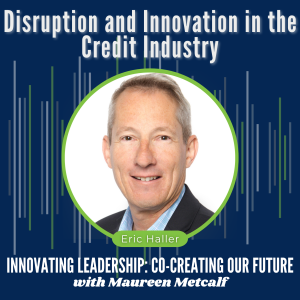
Friday Mar 03, 2023
Friday Mar 03, 2023
Guest: Eric Haller
The future of credit is quickly evolving in today’s digital world. Eric Haller joins the program today to share about the importance of virtual and augmented reality, voice and text for credit, and the use of artificial intelligence and machine learning, which are both paramount in the transformation of credit.
Continued Innovation: Experian DataLabs
Eric Haller, Executive Vice President of Experian DataLabs, provides this blog. Eric shares the programs and resources Experian is innovating to make a difference in the fight against the pandemic as a companion to his podcast Disruption and Innovation in the Credit Industry.
At Experian, we’re dedicated to innovation, and the COVID-19 pandemic has been an impetus for further innovation. Our driving force of successful innovation is our employees. We foster a culture of continuous innovation, from the way we work to the solutions we create.
Global Hackathon
As part of our effort to mitigate the impact of the pandemic, we’re launching Experian’s first-ever Global Hackathon. Taking place between June 1 and 5, we’ve invited all our employees to get involved and connect, share knowledge and find new ways to help our clients and consumers on the road to recovery from the COVID-19 pandemic.
Mitigating COVID-19 Crisis Through Our Innovations
In addition to the Global Hackathon, we’ve committed vast resources to develop innovative technologies and new sources of data and analytics to drive solutions that help people, businesses and society at large.
For example, to aid in the United States re-opening efforts, Experian has made available a free interactive U.S. map showing populations at-risk of being most susceptible to developing severe cases of COVID-19. The Experian COVID-19 Outlook and Response Evaluator (CORE) tool is intended to help guide healthcare organizations and government agencies as they plan for COVID-19 recovery in the months ahead. The map leverages de-identified data such as pre-existing conditions and social determinants of health to form a comprehensive picture that predicts possible pandemic impact on communities.
To help essential organizations during the pandemic, Experian also created At-Risk Audiences, which leverage our data assets to identify groups of individuals that are most likely to be impacted. These new privacy-compliant segments, offered free of charge, are designed to help these organizations find and communicate with at-risk populations, enabling them to deliver essential services as quickly as possible.
In the UK, we’re working side–by–side with the government. As part of this, we’re building models to help predict how this disease will spread in local populations and predict the effectiveness of various treatment therapies.
In Brazil, we’ve organized a coalition of universities, data companies and technology leaders to launch Covid Radar with the purpose of working together to minimize the impacts generated by the COVID-19 pandemic and contribute to the recovery of Brazil’s economy. The Covid Radar integrates companies to the hospitals and communities that need donations of ventilators, personal protection equipment, or other supplies. In addition to providing case monitoring and disease forecasting.
The COVID-19 crisis has forced innovation and change on a scale and pace we wouldn’t normally see. We remain relentlessly focused on helping vulnerable communities, strengthening the resilience of businesses, and playing an important role in helping consumers and the world economy get back to strength. As part of our global innovation program, we’re hosting a global hackathon to help our employees create new ways to help our clients and consumers on the road to recovery from the COVID-19 pandemic.
As one of the world’s most innovative companies, we’re doing everything at Experian we can to provide our unique insights back to key stakeholders so they can prioritize help those who need it most urgently.
About the Author
Eric Haller is the Executive Vice President and Global Head of Experian DataLabs. Experian DataLabs is responsible for developing innovative products generated from break-through experimentation leveraging artificial intelligence and data assets from a variety of sources. He led the creation of labs in the US, UK & Brazil that support research & development initiatives across the Experian enterprise. Prior to Experian, Eric was responsible for new products with Sequoia Capital backed Green Dot. Eric also co-founded identity fraud detection business iDawg which was later renamed ID Analytics. ID Analytics was acquired by LifeLock which is now part of Symantec. Other roles held by Eric includes Chief Marketing Officer of the first publicly traded machine learning company and executive roles with Visa & MasterCard.

Friday Mar 03, 2023
Friday Mar 03, 2023
Guest: David Goldsmith
David Goldsmith joins the show to share why leaders need great coaches. The world is increasingly complex, and leaders are asked to make decisions in volatile, uncertain, complex and ambiguous environments. Usually without enough information. With the speed of business so fast, great leaders need coaches and not just good coaches, great coaches.
The Benefits of Using a Great Coach in a VUCA Environment
This blog is provided by David Goldsmith of 7 Paths Forward, LLC. as a companion to his podcast as a part of the WBECS (The World Business & Executive Coach Summary) Series, The Benefits of Great Coaching in a VUCA Environment.
VUCA stands for Volatile, Uncertain, Complex and Ambiguous. It’s a term that comes from the military to describe conditions during war. The current pandemic has highlighted and accelerated the disruption that leaders were already experiencing in their organizations. Now when we talk about VUCA more people have a first hand experience of what we are talking about.
The world is volatile right now. Everyday things change. We don’t know when and if things will return to how they used to be. This creates a lot of the uncertainty that we are all experiencing. Just as we think we know how things might be, we learn new things and our view changes rapidly. Sometimes we experience this change hourly! It’s a lot to keep up with.
It’s hard to imagine a time when things were more uncertain. When will children go back to school? How long will we work from home? Will there be further waves of the virus? How will we deal with those? What does “normal” look like in the future? How will this affect organizations? What kind of work will there be? What do we want to keep and preserve from the disruption?
The complexity has only increased. As a leader you had your OKRs for the year. How do you accomplish those goals with your workforce configured very differently? How do you get these done when your workforce is facing childcare challenges and experiencing a level of stress and personal disruption previously unknown?
The pandemic has also been a great example of ambiguity. We are watching governments manage a public health crisis and an economic crisis at the same time. There are no easy or right decisions. Every decision has consequences. And you never have enough information to make a decision. You have to choose and then be prepared to update your decision very quickly!
Coaches help leaders grow and develop and handle more complexity. Great coaches help their clients do this more efficiently and with deeper results. A simple example is inter-city trains. In many parts of the world you can take a train service from city a to city b that might take ten hours. Or you can take a high-speed train that makes the trip in six hours. The high-speed train is usually more comfortable and gets you there significantly faster. Both options get you to your destination.
During this pandemic we are finding that leaders are making time for their coaching sessions. However, many times these sessions are shorter. A great coach can efficiently work with the client to identify the issues, help them develop actionable insights and help them get on with their VUCA challenges.
To deal with these VUCA challenges requires a coach who has the experience, skill and insight to customize their work to provide what these leaders need now. They must be agile, insightful and armed with a large toolbox of skills and approaches. They must themselves be comfortable in a VUCA environment.
When you have to make a complex decision without enough information, you need a coach who can lean in to the conversation, help you understand all four of the VUCA elements and then help frame the issue so that the leader can make their best decision. And the coach is standing by ready to help that leader adjust (because they will need to).
Leaders also need great coaches who can work with a variety of narcissistic, defensive and emotional clients. All of us are dealing with a far greater level of conscious and unconscious stress. Leaders are behaving in ways that are unusual and often surprising to themselves. They need a coach who isn’t fazed by this and in fact knows how to utilize this new behavior to help the leader accelerate their growth.
Our current environment is a great example of why leaders who want to grow, develop, and thrive need to work with a great coach.
About the Author
A pioneer in the coaching industry, David Goldsmith was Chief Operating Officer of CoachInc.com and past President of CoachU. He has staged many innovative conferences on coaching and was the first to showcase coaching research almost 20 years ago. He co-founded the Foundation for Coaching which has now become the Institute of Coaching at Harvard. he has also co-founded Accelerating Coach Excellence, a program dedicated to helping coaches get to the heart of client issues in less time. David is an active coach working with senior leaders, professionals, and entrepreneurs around the globe. He has also coached many of the leaders in the coaching profession helping to grow the impact of coaching worldwide.
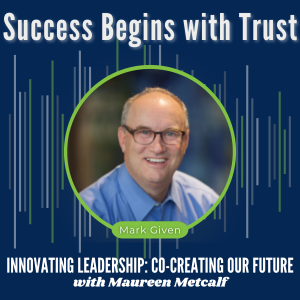
Friday Mar 03, 2023
Friday Mar 03, 2023
Guest: Mark Given
“Our world and our businesses revolve on the level of Trust people have in us. Success begins with Trust and ends when Trust dissolves.” This quote by Mark Given is the basis for this show. Mark joins Maureen to discuss the topic of trust and the importance of trust to help leaders succeed.
Success in Life Begins with TRUST
This blog is provided by Mark Given, Founder of the Trust Based Philosophy. It is a companion to his podcast Success Begins with Trust.
In leadership, sales, relationships and in all aspects of life, success and happiness has always been built on a foundation of TRUST.
You already know that to find fulfillment, people need a life-long quest for growth and learning.
Building, maintaining, and repairing Trust are all key parts of that growth and the evidence often slaps us right in the face…nearly every day.
People (maybe even you) leave companies every day, not just because of poor products or unsafe conditions, but because of lousy untrustworthy leadership. Customer trust is regularly so low that repeat rates are consistently and dismally small. Even in human relationships lack of trust is painfully evident and cities everywhere are experiencing riots in the streets.
The concept of TRUST has been taught by many well respected and admired authors, philosophers, psychiatrists, and business experts for years. What’s lacking in their reports though is the actual science practice of establishing, building and maintaining trust.
Having been focused on the study and practice of trust for nearly four decades, I discovered what I believe to be the essence of how to build and maintain deeper levels of Trust.
I call it the Pyramid of Trust:
Introduction Facet or your Grand Opening phase
Rapport Facet – or the question and listening phase
Maintenance Facet – or generously giving not taking phase
Repair Facet – or the sincere and transparent apology phase
Speaking of the Introduction Facet, research from a recent 15-year Harvard University study showed that if adults assume their ability to discern trustworthiness in strangers is a skill honed over a lifetime, they are wrong. Even children ages 5 and 6 make the very nearly the same judgment about the trustworthiness of adults, and children ages 3 to 4 were only off by just a few percentage points from adults.
People make inferences (right or wrong) about strangers’ characters within 50 milliseconds of viewing them and a NYU study showed the results to be even less (33 milliseconds). In today’s words, we call that profiling, and while they are profiling you, YOU are profiling them too!
You can improve this negative impression someone might have of you in part by moving from a two-step greeting to a three-step greeting, making your initial introduction more about the other person than yourself. The key is to move your dialogue from the emphasis on YOU to focusing on THEM, and the results have been shown to be quite amazing.
In the Building Rapport Facet, a smart person will learn to ask more questions and really listen to the answers. Recently, in an interview Jack Canfield did with me on my Trust Based Philosophy books, Jack offered a wise thought. He said, “focus on becoming more interested than interesting”. Jack is exactly right (and he wisely gave the credit for this wisdom to his wife Inga).
The benefit is three-step greeting principle is that, when done properly, you learn much more about the other person which allows you purpose driven reasons to massage the relationship, stay in touch and serve them better (assuming they are a good match for you personally and professionally).
To succeed in the Maintenance Facet, you focus on becoming more of a giver than a taker. Read the wonderful book The Go-Giver by my friends Bob Burg and John David Mann and you will better understand the importance, relevance and success that come from being a giver. Building TRUST is maintained over a lifetime. It’s a marathon, not a sprint.
And finally, assuming you are actually human…we all make mistakes. We say and do foolish things. Understanding the proper art and science of the Apology Facet is life and business changing.
You already know how hard it can be to effectively and successfully apologize and yet you also know how important it is to your happiness, profitability, and the growth of Trust.
Creating a successful life and business is hard. Maintaining valuable relationships is difficult.
The results of better understanding, creating, and maintaining deeper levels of TRUST are what will bring you the joy and success you are seeking.
Become a master of “The TRUST Based Philosophy” and life will be your oyster. I guarantee it!
About the Author
Mark Given is an Amazon #1 selling author of 8 books and has been teaching the importance of TRUST for four decades.
Because of his personal and professional observation and experience, he has written four top selling books under the theme The Trust Based Philosophy.
Trust Based Leadership – Proven Ways to Stop Managing and Start Leading
Trust Based Selling – Proven Ways to Stop Selling and Start Attracting
Trust Based Success – Proven Ways to Stop Stressing and Start Living
Trust Based Networking – Proven Ways to Stop Meeting and Start Connecting
You can reach Mark at: mark@markgiven.com.
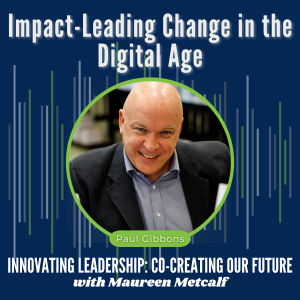
Friday Mar 03, 2023
Friday Mar 03, 2023
Guest: Paul Gibbons
With great power comes great responsibility. Our spiritual evolution and collective wisdom struggle to keep pace with the power granted by our technological evolution. Harnessing the good business does by scaling science for the benefit of humanity, through creating communities where people can learn—and contribute more than they could alone—and by furthering human flourishing are among noblest aims we may pursue. In this show, Paul Gibbons joins Maureen to discuss the future toward which business is leading us, in 2030,and how it is the backdrop to our change. We have in our hands, as citizens and as business leaders, the power to do great good by pointing business toward our most inspirational and useful aims and leading those changes with passion and reason.
Practical Advice for Businesses in Crisis – Emerging
The following is a guest blog written by Mike Sayre. It is a companion to the interview with Paul Gibbons titled Impact-Leading Change in the Digital Age.
What to start pushing forward on as you think about emerging from this crisis. You do need to push forward!
In the a previous two article, you learned about communicating openly and honestly with your team and understanding your cash and credit resources to push forward. But what do you push forward on?
Because this blog series is meant to be both practical and tactical, I am assuming that you and your company already have a mission, vision and values that are all in alignment and are the basis for the culture of your business. If not, please check out my At C-Level blogs 2, 3 and 4 at the Innovative Leadership Institute website.
As I write this, much of the world is in some kind of lockdown status for “non-essential” businesses. A major indicator that your business is not as essential as you might like it to be, is that during the pandemic, your business was either designated as “non-essential” or your sales dropped like a rock and will take months, if not years, to recover. Whenever your sales are falling off significantly, most of the following applies as well. You always want your business to be “essential” to fulfilling the needs of your customers!
Of course, there are varying degrees of “essential” and some businesses will rebound more quickly than others. What degree of “essential” is your business?
To get a gauge on that, ask yourself, “What are people doing or buying right now instead of what we provide and, more importantly, why?
Then ask yourself,
“If the pandemic ends tomorrow, will they immediately come back to us as customers?”
“If not immediately, is there something we can start doing now to incentivize them to come back sooner?”
“Is it possible they will continue on with what they are doing now and not need us at all, or nearly as much, going forward?”
In any of these three cases, it’s time to engage with your customers and your team to come up with appropriate incentives to insure they come back and as soon as possible, or come up with new directions to keep them from splintering off to those new-found alternatives…which, actually, you and your team should be doing on a regular basis anyway!
If that all sounds like Marketing 101, it is. But it is amazing how much we forget and how far away we can get from our customers in a pandemic, or when things have just been going really well for a while! Your owners, customers, employees, suppliers and communities are all depending on you and your team to be thoughtful and committed in this process!
What does the business and/or its offering need to look like to not only keep current customers, but also to attract new customers as your business emerges from your crisis? Fact is, you will need new customers to fill in for current customers who just won’t come back no matter what you do, and to grow the business and thrive again going forward. What are your competitors doing? Is that what your customers want? Is your new offering really a compelling proposition for your customer and for your business?
Sales in our profitable electronics repair business (something like $12M-$15M at the time) with customers like Oracle, HP, Xerox and IBM were in decline…a crisis for us. Our customers told us we were being excluded from new bidding processes because we only had one location, which made the shipping cost of doing business with us too expensive. To be added back to the bidder lists, we needed to add our own repair locations in Europe and Asia like our much larger global competitors. Our vision had to be “adjusted” from being “the best in the business at what we do” to being “the best in the world at what we do!” We already had an international salesperson selling our customized electronic solutions who had made some nice partnership connections for us in The Netherlands and Hong Kong. So, we cultivated those connections into relationships, raised money from investors, bought a small well-run repair business in The Netherlands, and partnered with our repair contact in Hong Kong to create a small joint venture operation there. We were then put back on the bidding lists, the repair business started growing again, and we eventually achieved our vision to be “the best in the world,” according to our largest customer! Yes, this is a much bigger story, but I think it illustrates the point.
Now that you have some ideas on how you want to emerge from this crisis, you need to focus on what will have the biggest impact for your customers and business, based on what you can actually do considering your resource availability and/or constraints.
I sometimes use a quick model to evaluate such ideas/alternatives with my team:
"Impact" can be short term or long term. So you have to consider your time horizons on each alternative.
"Resources" can be financial, expertise, people, equipment, facilities, etc. Considering all of these, how would you rate it in terms of being possible for your business to do it?
"Score" is just multiplying your two ratings. This is where your risk analysis comes in.
Idea #1 is a slam dunk for an okay impact at best.
Idea #2 would have a huge impact, but is really beyond your resources in a big way.
Idea #3 would have a sizable impact, and you have the majority of what you need...do you have the money or other less obvious resources to fill in what's missing?
This is just one way to look at it and a place to start. The larger the potential investment, the more analysis you really need to do. If you have the resources to do more than one of the alternatives, and they all make sense strategically, redo the model by taking out the best alternative and assume those resources no longer exist. Re-rate, score, and decide.
Please don't let any model substitute for your common sense! Your results should mirror your intuition. If not, I'd think it through again.
Now, it’s time to think about the people and capabilities in-house that can be redirected to build up new business capabilities without causing major disruption in the current business, depending on how large the challenges are in the current business.
About the Author
Mike Sayre has successfully piloted businesses through difficult times of crisis for over 20 years – as a CEO, COO, CFO, and/or Board Director. He is currently an independent executive leadership consultant working through Civilis Consulting and the Innovative Leadership Institute, trusted partners inspiring and enabling perpetual innovation, evolution, and growth in leaders and their businesses. If you would like to learn more or get help, please contact Mike through LinkedIn.
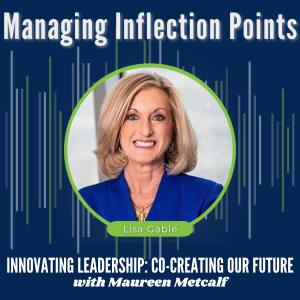
Friday Mar 03, 2023
Friday Mar 03, 2023
Guest: Lisa Gable
Lisa Gable, CEO of FARE, has managed several major turning points within her work experience. At FARE, with food allergy, the organization is at several major inflection points with the first peanut allergy therapy receiving FDA approval, gene editing in agriculture, consumer packaged goods and artificial intelligence. Lisa joins Maureen to help leaders understand when they are at an inflection point and how to optimize and maximize results for their organization and society’s benefit.
Nimbly Moving Through the Next Inflection Point
This blog is provided by Lisa Gable, CEO of FARE, Food Allergy Research Education as a companion to her podcast Managing Inflection Points.
Having worked through many times of significant global change, most notably the dot.com bust and 9/11, I quickly learned the importance of being agile in my professional and personal life. I had to “zig and zag” while maintaining a positive outward face in business, while building a home environment based on readiness and resilience.
For those of us who are not experiencing our first inflection point (aka the Covid-19 crisis), we have the advantage of a lifetime of managing and surviving stressful situations. By your early 50s, there is a higher likelihood that you will have suffered a few life altering events and have managed through booms, busts, and heartbreaks.
I’ve seen probably more than my fair share of inflection points in history, including with my time at the Reagan Defense Department during the final days of the Cold War. And, when I joined FARE back in 2018, I inadvertently created an inflection point for the organization. My remit was to restructure the organization and drive philanthropic and industry investment to help fund new therapies and diagnostics.
If Covid-19 is the first time you are confronting an inflection point, don’t worry – there is time to more fully develop very specific resilience and coping skills. In the meantime, here is some advice for budding and senior managers during this crisis and others that will inevitably follow:
Offer mentorship and coaching and consider what you can do to help alleviate the unique stressors of Covid-19.
Work to balance the needs of business against people’s fears. Be human and approachable. Share your own story in a manner that is comfortable for you so that you can take part in open dialogue.
Encourage co-workers not to hide their challenges, but to share them. Challenges may that remain tucked away can negatively impact the ability of peers to meet their goals, including thriving personally through the inflection point. Awareness of a unique situation become points of information for creating systems and tools.
Foster a culture of collaboration which transparently recognizes barriers and encourages teammates to work together to build a path forward which works for the team.
Realize that everyone will hit a mental wall at some point – even you. Even the strongest employee will eventually become overwhelmed. Be prepared for the moment and provide a safe environment for the individual to take a mental health break for a few hours, the afternoon, or a day.
Take your vacation and encourage others to schedule theirs, also. Burn out is real and renewal is required to meet the uncertainty that is still to come.
The point about inflection points is - you just don’t know when they will arise. They just happen. To everyone. So, to be prepared means you are a better prepared manager, colleague, friend, and parent.
About the Author
Lisa Gable is CEO of FARE, Food Allergy Research Education, the largest private funder of food allergy research advocating on behalf of the 32 million Americans living with potentially life-threatening food allergies. Lisa's passion, expertise, and fearless workstyle have propelled her to achieve the titles of CEO, US Ambassador, UN Delegate, Chairman of the Board, and advisor to Presidents, Governors, and CEOs of Fortune 500 and CPG Companies worldwide.
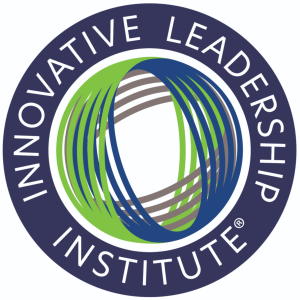
Friday Mar 03, 2023
Friday Mar 03, 2023
Guest: Mike Hardy
Better leadership, like peace, is a critical factor for human flourishing –with better leadership societies can begin to address many of the sources of human insecurity- but often, just as with peace, we remain more aware of its absence than its existence. Mike Hardy, Founding Director of the Centre for Trust, Peace and Social Relations at Coventry University in the UK, joins Maureen to discuss his current work, trends in democracy and what leaders can be doing to make a difference through better leadership for a more peaceful existence for us all.
